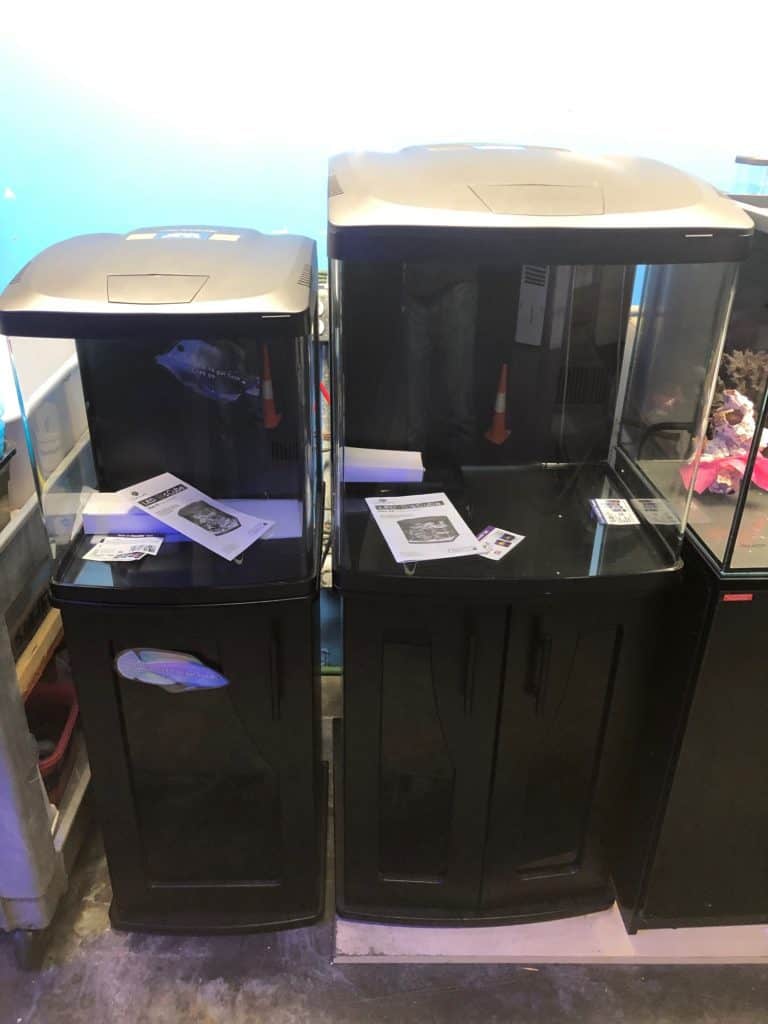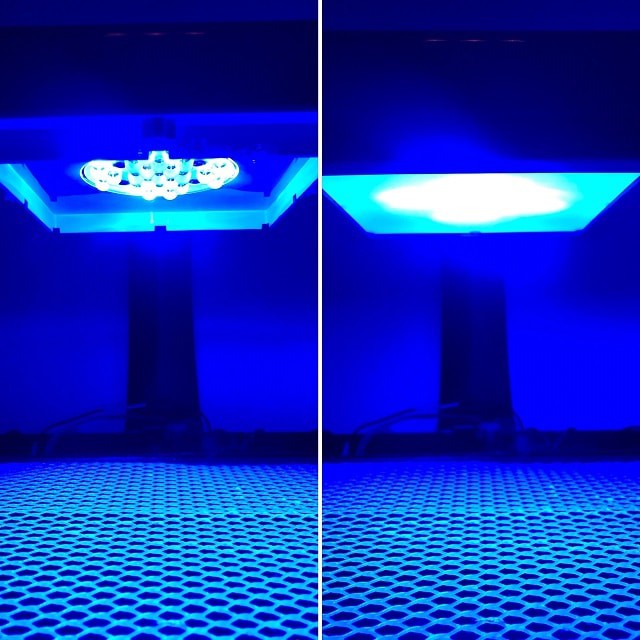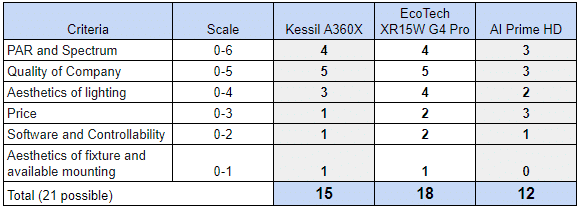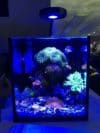Don’t fall into the trap of making everyone else’s mistakes when selecting nano reef lighting. People are creatures of habit. Often we follow the crowd. We worry too much about what others think of them. We need to start thinking for ourselves!
Nano Reef Lighting:
Nano reef lighting is aquarium lighting that provides the photosynthetically active radiation (PAR) and lighting spectrum necessary to support fishes, invertebrates and that promote coral growth and coloration in nano reef tanks. The 4 most popular types of nano reef lighting are:
- LED
- T5 Fluorescent
- Metal Halide
- Hybrid
Nano tank reef lighting – an overview
Reef lighting can be one of the most expensive components in today’s reef aquarium market. This is especially true compared to the cost of the nano reef aquarium. Some options can cost over one thousand dollars for just the basic fixtures, not counting brackets, extensions, diffusers, etc.
Don’t complicate your decisions by doing what everyone else is doing for reef lighting, especially nano tanks.
Decision Hack: There is a proven method at the end of this article that will help you make the right decision based on your preferences, so keep reading! I won’t tell anybody if you are impatient and jump ahead.
Nano Reef Adviser Hack
We all know that reefing – even with a nano tank – can be a costly hobby. Reefing becomes much more expensive when money is spent needlessly. Poor decisions can make you have to buy different equipment due to changes you make to your tank. Buying lighting you thought was fantastic, just to find it doesn’t perform like you thought it would.
For nano reef tanks, lighting options really boil down to LED fixtures.
- Small form factor: You don’t want the size of your reef lighting to overwhelm your nano tank. The small footprint of LED lighting can actually be attractive when properly mounted.
- Very little heat: It doesn’t take much heat from your reef lighting to warm the relatively small water volume of a nano reef tank. LED heatsinks and fans have come a long way to keep them much cooler than other nano reef lighting options.
- Value options: There are value option lights available – especially for smaller sized nano tanks. In fact, many nano tanks come with LED lighting as part of a kit or built into the lid.

Nano reef lighting options: What’s most important
To make an informed decision, you should research available lighting. Check out your local fish store (LFS) manufacturer websites, large online vendors like Bulk Reef Supply or Marine Depot. Watch YouTube videos to see what the quality and type of lights are available. You don’t want to buy any LED fixture sight unseen.
Reef Lighting Coverage: A key element in your lighting will be the size of the ‘spread.’ Essentially, this is the tank area that the fixture output will properly cover. The spread dimensions usually come in two flavors – maximum spread and recommended spread. Obviously, the light quality in the recommended spread is better than the outer edges of the maximum spread. If you are trying to provide proper lighting in a reef tank that is larger than the maximum spread, then you will have inferior results overall.
Reef Lighting Penetration: Another element important in reef lighting fixtures is how far the light will penetrate below the water’s surface. It isn’t unusual to have fixtures that can penetrate 18-24 inches. This is perfectly fine for most nano tanks, but if you need deeper light than 24 inches, you will need to verify that during your research.
When evaluating LED lighting options for your nano reef, you should (at least) review the performance criteria listed below (in no particular order.)
Price:
Let’s be real. You should have a budget and do your best to stick to it. If a reef lighting option is over your budget, you should eliminate it and move on. However, if it turns out that your needs require you to spend above your budget, then you have to re-evaluate your plans or sell something in the garage.
The easiest first step in selecting your nano reef lighting is to eliminate from consideration all of the lighting options that are above your budget.
Quality of the Company:
What kind of service and warranty support do you expect? How long do you want to be down if you have to wait for a replacement power supply? Purchasing products from unknown or new companies can be a risk if they have no reputation to uphold.
Aesthetics of fixture and available mounting:
Does it look like a well-designed and well-built piece of electronics? You will see this fixture as much as you see your tank and stand; it would be nice if it didn’t distract from your tank’s overall appearance and enjoyment.
Many nano reef lighting options include sleek profiles, very low noise, and awesome mounting brackets that fit almost every tank configuration.
Aesthetics of lighting:
One of the top qualifiers for sure! This is how the reef lighting looks inside your nano tank. Is the color nice, is it well blended, or does it look like multi-colored spotlights hitting the tank from different directions? Do the colors look like a disco with color flashes all over the tank? If the light isn’t blending well or looks like a flashing disco ball – does the company offer a diffuser option for the fixture, and does that correct the issues?

PAR and Spectrum:
You want your nano reef lighting to do two things really well. You want your lighting to maximize coral growth and maximize coral coloration. Nobody buys coral frags and wants them to stay frags forever. We want those frags to turn into a big colorful colony!
The available spectrum in your LED fixture and its photosynthetic active radiation (PAR) at different areas of your nano reef tank will be what decides whether your corals grow like weeds or wither and die (from a lighting perspective anyway.) The quality of the spectrum blending will also affect coral performance.
Coral Growth Hack: I know this is an article on nano reef lighting options, but keep in mind there are two other key components to coral growth and coloration that are at least as important as the quality of lighting. Water quality and Flow. If you don’t maintain proper water chemistry/parameters and provide enough flow for corals to perform biological functions, then the quality of lighting will not guarantee how well your corals perform.
Nano Reef Adviser Hack
Software and Controllability:
How much spectrum and intensity adjustment are available? Is there software for my devices so that I can adjust them remotely? Is it web-based? Does it connect with WiFi, or does it have to be hard-wired?
Selecting the right nano reef lighting option – use a weighted decision matrix!
Whenever I am trying to make a tough decision, I use a weighted decision matrix. A weighted decision matrix is essentially a spreadsheet that can assist you by making complex decisions simple.
It is beneficial in situations where you evaluate several alternatives (e.g., which LED fixture to buy) over a lot of criteria (e.g., what features/performance qualities are most important to you.)
Follow these steps in this exact order to avoid letting your emotions or predetermined mental result from influencing the process.
Step 1:
Select your criteria
You could use the criteria listed in this article,
- Price
- Quality of Company
- Aesthetics of fixture and available mounting
- Aesthetics of lighting
- PAR and Spectrum
- Software and Controllability
Or, you can change or add to the list as you see fit. Maybe available mounting options, length of time on the market, or even product reviews are important to you. Add whatever ever criteria
Step 2:
Order your criteria, starting with the most important criteria (to you) at the top and the least important at the bottom. Remember, this is based on your needs and desires.
Step 3:
Provide a point scale. If you have a list of 7 items, the most important criteria (top of the list) would have a point range of 0-7, the second a point range of 0-6, the third 0-5, and so on until you reached the least important criteria (bottom of the list) with a point range of 0-1
Step 4:
Add the lighting options (LED fixtures) in columns and rank each light using the criteria point scale. Don’t total up the numbers until you have filled out the rating for all the options!
Step 5:
Total up the points of each lighting option. Congratulations! The result represents which LED best meets your criteria, and you have now made your own decision based upon what’s most important to YOU!
Step 6:
Delete the file from your computer and buy the one your friend told you to buy in the first place. Please don’t do it! The goal is to do what is right for you – not to follow the crowd.
Here is an example of my selection process when I bought my recent LED.

In this example, based on my criteria and how I viewed each fixture, the resultant totals pointed me to the EcoTech product as rated highest, so that is the fixture I purchased.
For the software and controllability criteria, I was reviewing based on the fixture’s potential ease of connection to my controller system.
Getting the most out of your nano reef lighting
Now that you have made your reef lighting decision, how do you make the most of it?
Just because you have a fixture that can blind you from 200 yards doesn’t mean you should unleash all of that power on your unsuspecting corals. You can kill a coral faster with too strong of light than you ever could with too low of light. Depending on your mounting height, you will likely have to reduce the intensity for the best results.
Start slow and acclimate your corals to your new nano reef lighting. You can build up the PAR over several weeks. Follow PAR and spectrum recommendations of the manufacturer as a good starting point.
You can also program your lights acclimation settings if available. Good luck!
Interested in more information about PAR and spectrum with LED lights? Check out my post. How much LED light for reef tanks?
